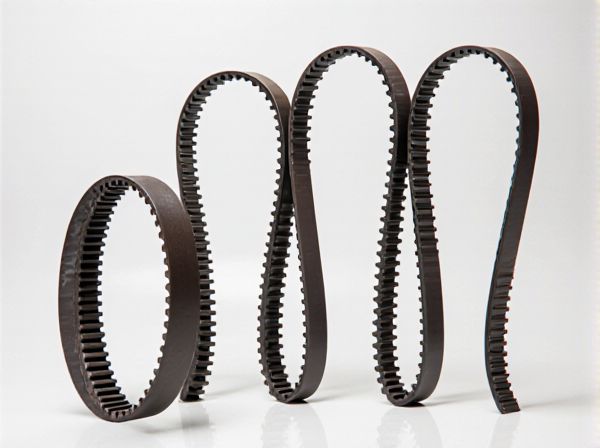
Photo illustration: Rubber Timing Belt vs Polyurethane Timing Belt
Rubber timing belts offer flexibility and cost-effectiveness, making them suitable for standard automotive and industrial applications. Polyurethane timing belts provide superior durability, resistance to wear, chemicals, and temperature variations, ensuring longer service life in demanding environments. Choosing the right belt depends on your specific needs for strength, environmental resistance, and longevity.
Table of Comparison
| Feature | Rubber Timing Belt | Polyurethane Timing Belt |
|---|---|---|
| Material | Natural and synthetic rubber | Durable polyurethane polymer |
| Durability | Moderate; prone to wear and cracking over time | High; resistant to abrasion and chemicals |
| Temperature Resistance | Up to 100degC (212degF) | Up to 120degC (248degF) |
| Flexibility | Good flexibility for smooth operation | Stiffer but maintains shape under stress |
| Noise Level | Low noise during operation | May produce higher noise due to stiffness |
| Cost | Lower cost and widely available | Higher cost, specialized applications |
| Lifespan | Typically 60,000 to 100,000 miles | Typically 100,000 to 150,000 miles |
| Common Use | Standard passenger vehicles | High-performance and industrial vehicles |
Introduction to Timing Belts
Timing belts are essential mechanical components designed to synchronize the rotation of the crankshaft and camshaft in internal combustion engines, ensuring precise valve timing. Rubber timing belts, composed of synthetic rubber with embedded fiberglass cords, offer flexibility and cost-effectiveness but are prone to wear under extreme conditions. Polyurethane timing belts, reinforced with steel or Kevlar cords, provide superior durability, chemical resistance, and tensile strength, making them ideal for high-performance and industrial applications.
Material Composition: Rubber vs Polyurethane
Rubber timing belts are primarily composed of synthetic rubber compounds such as neoprene or nitrile, offering excellent flexibility, resistance to abrasion, and heat but are prone to degradation from oils and chemicals. Polyurethane timing belts consist of a thermoplastic elastomer with embedded steel or Kevlar cords, providing superior tensile strength, chemical resistance, and durability in harsh environments. The choice between rubber and polyurethane materials directly impacts the belt's performance in terms of wear resistance, load capacity, and lifespan in various industrial applications.
Durability and Longevity
Rubber timing belts offer moderate durability with good flexibility but tend to degrade faster under extreme temperatures and chemical exposure compared to polyurethane timing belts. Polyurethane timing belts excel in longevity due to their superior resistance to abrasion, chemicals, and high temperatures, making them ideal for demanding industrial applications. Enhanced tensile strength and wear resistance in polyurethane belts result in longer service life, reducing maintenance frequency and operational downtime.
Performance and Efficiency Comparison
Rubber timing belts offer excellent flexibility and vibration dampening, making them ideal for moderate-speed applications with lower noise levels. Polyurethane timing belts provide superior abrasion resistance and higher tensile strength, enhancing performance and efficiency in high-speed, high-load environments. The choice between rubber and polyurethane affects overall system durability, energy consumption, and maintenance intervals significantly.
Resistance to Chemicals and Oils
Rubber timing belts generally exhibit moderate resistance to chemicals and oils but can degrade quickly when exposed to harsh solvents, petroleum products, or prolonged oil contact. Polyurethane timing belts demonstrate superior resistance to a wide range of chemicals, including oils, greases, and most industrial solvents, making them more durable in chemically aggressive environments. This enhanced chemical resistance helps polyurethane belts maintain tensile strength and flexibility, resulting in longer service life under demanding oily or chemical exposure conditions.
Temperature Tolerance
Rubber timing belts typically withstand temperatures ranging from -30degC to 100degC, making them suitable for moderate operating environments. Polyurethane timing belts offer superior temperature tolerance, functioning reliably between -40degC and 120degC, which enhances their performance in more extreme conditions. This wider temperature range makes polyurethane belts ideal for applications requiring greater thermal resistance and durability.
Noise and Vibration Levels
Rubber timing belts typically generate higher noise and vibration levels due to their inherent material flexibility and surface texture, which can lead to increased friction during engine operation. Polyurethane timing belts offer superior noise dampening and reduced vibration because of their enhanced material stiffness and smoother surface profile, contributing to quieter and smoother engine performance. Choosing polyurethane belts can significantly improve acoustic comfort and mechanical stability in high-precision or performance-driven applications.
Maintenance and Replacement Costs
Rubber timing belts generally require more frequent replacement, typically every 60,000 to 100,000 miles, due to faster wear and susceptibility to cracking, which leads to higher long-term maintenance costs. Polyurethane timing belts offer superior durability and resistance to abrasion, chemical exposure, and temperature extremes, extending their lifespan up to 150,000 miles and reducing replacement frequency and overall maintenance expenses. While the initial cost of polyurethane belts may be higher, their extended service life and lower maintenance requirements make them more cost-effective for long-term use in automotive and industrial applications.
Application Suitability: Industries and Uses
Rubber timing belts are preferred in automotive engines, industrial machinery, and agricultural equipment due to their flexibility, cost-effectiveness, and vibration damping properties. Polyurethane timing belts excel in high-precision applications such as robotics, packaging machines, and medical devices, offering superior wear resistance, chemical stability, and load-carrying capacity. Selection depends on operational demands like temperature resistance, chemical exposure, and load conditions specific to manufacturing, automation, or transportation industries.
Choosing the Right Timing Belt for Your Needs
Rubber timing belts offer flexibility and excellent grip, making them ideal for standard automotive and industrial applications that require shock absorption and cost-effectiveness. Polyurethane timing belts provide superior durability, chemical resistance, and tensile strength, suited for high-load environments and precision mechanical systems. Selecting the right timing belt depends on factors like load capacity, environmental exposure, and required lifespan, with polyurethane belts preferred for heavy-duty tasks and rubber belts for general-purpose use.
 caratoz.com
caratoz.com